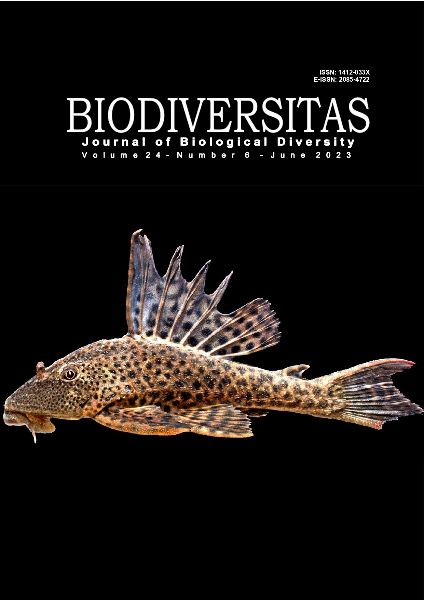Anatomical, morphological and physiological leaf characters of black betel (Piper betle L. var. nigra) in varying natural and man-made habitats
##plugins.themes.bootstrap3.article.main##
Abstract
Abstract. Kuswandi PC, Ariyanti NA, Yunus MF, Amri CNAC. 2023. Anatomical, morphological and physiological leaf characters of black betel (Piper betleL. var. nigra) in varying natural and man-made habitats. Biodiversitas 24: 3236-3244. Piper betle L. var. nigra or black betel (known as Sirih hitam in Indonesia) contains valuable secondary metabolites, such as alkaloids, flavonoids, saponins, tannins, phenols, carotenoids, steroids and terpenoids. Black betel leaf extract has been shown to have antimicrobial activity thus there is a prospect to be developed as a promising herbal plant. Nevertheless, little information is available about its development as a medicinal plant. This research studies the influence of different habitats on several characters of black betel leaves with the aim to understand the suitable environmental conditions for the optimum growth of black betel plants. We used a survey method and random sampling of black betel leaves in four locations in Java Island, Indonesia, namely Banyuwangi which represents natural habitat, and Karanganyar, Ngaglik and Pakem which represent man-made habitats. Measurements of temperature, humidity, soil moisture and light intensity were carried out at each location. Analyses of leaf area, leaf water content, total leaf chlorophyll content and flavonoid content were undertaken and statistically analyzed using SPSS software. Leaf transverse sections were also observed. The results showed that the environmental parameters differed in the four locations. Leaves samples from the natural habitat in Banyuwangi were significantly different (P<0.05) from the three man-made habitats for chlorophyll and flavonoid content. For water content, significant difference was only for Banyuwangi samples with those from Karanganyar and Pakem. For leaf area, significant difference was only found between the Banyuwangi samples and Karanganyar. Observations on the transverse cross section of midrib of black betel leaves from the four locations showed structures that are generally found in Piper betle species, namely the presence of an epidermal layer, trichomes in the abaxial part of the leaf, several layers of the hypodermis, visible vascular tissue and the presence of secretion cells. There were several differences in the leaf anatomy such as greater number of trichomes on the leaves from Karanganyar, the secretory cells that were more visible in the leaves from Ngaglik and Banyuwangi and the sclerenchymal tissue that was more visible in the leaves from Banyuwangi. Such differences are likely influenced by variations in environmental parameters thus showing that the man-made habitat in the Karanganyar location can affect leaves characters similar to black betel plant grown in its natural habitat in Banyuwangi.
##plugins.themes.bootstrap3.article.details##
Most read articles by the same author(s)
- M. HAFIZHUL IMAN, PARAMITA CAHYANINGRUM KUSWANDI, SENA ADI SUBRATA, Genetic variation of the native Rusa deer (Rusa timorensis) in Java and Bali (Indonesia) as revealed using non-invasive sampling , Biodiversitas Journal of Biological Diversity: Vol. 25 No. 1 (2024)

